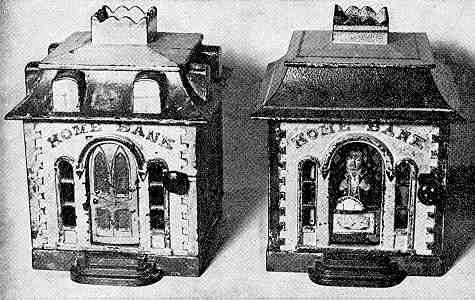Home Bank
by F.H. Griffith - HOBBIES Magazine - August, 1965

A mechanical bank having the possible unique distinction of being designed and patented by a woman is our choice as No. 133 in the numerical classification of mechanical banks. The bank is the Home Bank and, as can be noted in the picture, it was made in two types, one with dormer windows shown on the left and the other without the dormer windows shown on the right. This is not really important insofar as the rarity or value of either type is concerned. One is as good as the other in the writer’s opinion, and since both operate the same and are in the main alike, with the exception of the windows in the roof, they are not considered to be two different banks.
Insofar as mechanical banks go, the Home Bank is one of the very early ones. It was designed and then patented July 16, 1872 by Doras A. Stiles of Middletown, Conn. The drawings accompanying the patent papers are practically identical to the bank shown on the left in the picture. That is to say, in addition to everything else, the drawings show the bank with the dormer windows. J. & E. Stevens Company of Cromwell, Conn. manufactured the bank.
There is a known circumstance where a woman designed mechanical banks. M. Elizabeth Cook designed, but held no patents, on four mechanical banks made by the Kilgore Manufacturing Company of Westerville, Ohio. She was an artist and sculptress and made the models of the Frog On Rock, Rabbit in Cabbage, Owl (Slot In Head), Owl (Slot In Book), and the Turtle Bank (HOBBIES, November, 1955). Please note that she designed four banks, but that there are actually five since the Owl was made in two types. These are considered as two different banks. Their operating mechanism is not alike and the coin slot location in each is not the same. True this is a border-line case, but it is not of great importance either way one wishes to look at it. What does have some meaning is the possibility that two women designed mechanical banks, and one of them, if we are to assume that Doras Stiles was a woman, may have patented a mechanical bank.
The Home Bank can be referred to as a sturdy mechanical bank. There is not much that can go wrong mechanism-wise and it is not easily broken. However, it is rather unusual to find one of these banks in better than good paint condition. The banks shown are painted as follows: The one on the left has a white top roof with red edging, the roof section containing the dormer windows is blue, the windows are white with red crosslines thereon. The front, back and sides of the building are white with outlining of windows and other parts in red and blue. The name "Home Bank" is in blue. The front door is tan and brown with green striping. The figure of the cashier inside the bank has flesh color features and wears a brown coat and vest. This figure is cast iron as is the rest of the bank. The name "Cashier" which is cast under and in front of the figure is in white. Blue steps and base complete the coloring on this bank. The bank on the right has a yellow top roof with red and blue edging and striping. The section of roof with no dormer windows is red with a white stripe. The front, back and sides of the building are yellow with red and blue outlining of the windows and other parts. The name "Home Bank" is in red. The front door is red and light blue with dark blue striping. The cashier as shown in the picture is painted similarly to the one in the other bank, but has the detail of the buttons on his jacket and vest in yellow and black buttons on his shirt. The figure of the cashier in this case is made of a lead or pewter-like material. This figure is original. The rest of the bank is cast iron. The name "Cashier" is not on this bank. At one time there may have been a paper label with the name thereon similar to that used on the Hall’s Excelsior Bank. Red steps and base complete the colors of the bank.
The operation of the bank is simple but effective. The one on the left shows the bank before or after the operation, and the one on the right is pictured set to go. To accomplish this, the large knob to the right of the door is pulled forward. In so doing the figure moves into the doorway replacing the door, and the knob and lever in the forward position holds all parts in place by means of a slot in the lever. A coin is then placed in the provided section in front of the cashier as shown. The knob is then lightly pushed to the right and the parts all snap back into position as shown in the bank on the left. The cashier, of course, goes inside and the coin is propelled from its holder into the bank.
The Home Bank is a typical "savings bank" type mechanical bank since it represents a bank building complete with cashier. Either type, dormer windows or not, makes a nice addition to a collection.
As of this writing it is not known as a certainty that Doras Stiles was a woman. It is hoped that subsequent research will prove this out one way or the other.
* * * * * * * * * * * * *
CORRECTION
Last month’s article, Uncle Sam Bank, was erroneously listed as 131 in the numerical classification. This should have been No. 132. Sorry.
* * * * * * * * * * * * *
